    |
A BLUE AND WHITE JARDINIÈRE, TWO SPOONS, A FAMILLE NOIRE STEM CUP AND A FAMILLE ROSE TAZZA.
Qing Dynasty.
The jardinière of low rectangular form, wood stand 23 x 16 x 6cm, the spoons with Tongzhi mark to base, 13cm long, the stemcup with Qianlong nianzhi mark, 7cm H, the tazza 22cm diameter. (5)
£200-300
|
|

|
A FAMILLE ROSE 'BUTTERFLIES' BALUSTER VASE AND COVER.
Qing Dynasty.
Decorated with a continuous pattern of butterflies above a flower-filled pond, the base and neck with a floral border punctuated with quatrefoil panels of fish alternating with flowers or gourd plants, a key-scroll border to the rim, the cover similarly decorated, and with a gilt bud-form finial, wood stand, 63cm H.
£500-800
|
|
  |
A FAMILLE ROSE 'FIVE POISONS' DISH.
Early 20th Century.
The interior painted with the Daoist Zhang Daoling riding on the back of a scorpion, a sword in his right hand with a snake coiled around the blade, an iron red creature overhead whilst below a three-legged toad sits on a rock beneath a pine tree, with a small boy also standing on the ground holding a lingzhi spray, iron red Da Qing Daoguang nian zhi mark to base, 16.5cm diameter.
£2,000-3,000
Zhang Daoling and the 'Five Poisons' is an important motif symbolic of combating evil and is associated with the Duanwu festival on the fifth day of the fifth month of the Chinese lunar calendar. The five poisons, represented by the snake, centipede, scorpion, lizard and toad, are said to come out of hibernation at this time and their slaughter is a means of conquering the evil they represent.
|
|
  |
A CIRCULAR PORCELAIN 'DRAGON AND FISH' PLAQUE.
Late Qing Dynasty.
The coiled green dragon beside a pearl with accompanying flames, looking down on the iron-red fish, itself contorted to look upward to meet the dragon's gaze, reserved on a white ground with an incised wave pattern, 27cm diameter.
Provenance: English private collection.
£400-600
|
|

|
A FAMILLE ROSE 'PEACHES AND BATS' VASE.
Early 20th Century.
The body of the baluster form vase decorated with a peach tree trunk emerging from a rocky outcrop with attendant flowers and lingzhi fungal spray, the trunk with fruiting branches and supporting two exotic birds, 46cm H.
£500-800
|
|
   |
A PAIR OF UNDERGLAZE BLUE ENAMELLED FAMILLE ROSE VASES.
Qing Dynasty.
Decorated to the body and neck with birds and flowers on a blue ground, with a blue and white band to the base, rim and shoulders, decorated with landscape and floral patterns, 47cm H. (2)
£300-500
|
|

|
A FAMILLE ROSE VASE.
20th Century.
Decorated with a bird on a flowering prunus branch emerging from a rock beside bamboo branches with bats flying overhead, iron red Da Qing Jiaqing nianzhi mark to base, 22cm H.
£400-600
|
|
   |
A PAIR OF FANGGU VASES.
Late Qing Dynasty.
Decorated with birds and chrysanthemums on a turquoise ground with modelled elephant head ring handles, Da Qing Guangxu nianzhi mark to base, 30cm H. (2)
£1,200-1,500
|
|

|
A PORCELAIN 'LANDSCAPE' TEA TRAY.
20th Century.
Painted with a lone figure in a mountainous landscape, 26 x 29cm.
£200-300
|
|

|
A BLANC-DE-CHINE MODEL OF A GUANYIN.
Qing Dynasty, 18th Century.
Seated in long flowing robes on a lotus throne, 30cm H.
£800-1,200
|
|

|
A BLANC-DE-CHINE MODEL OF A FIGURE, MADE FOR THE PORTUGUESE MARKET.
17th / 18th Century.
Standing on a scrolling cloud base, in long flowing robe, a peach in the right hand, 39cm H.
£400-600
|
|

|
A BLANC-DE-CHINE 'PUXIAN AND ELEPHANT GROUP', TOGETHER WITH A FURTHER GUANYIN.
Qing Dynasty, 18th Century, and later.
The deity seated on the elephant which stands four-square with the head turned to the right, on a floral-decorated base, 20cm H / 18cm H. (2)
£500-800
|
|

|
A BLANC-DE-CHINE 'MARCO POLO' OCTAGONAL CENSER, COVER AND STAND.
Qing Dynasty, Kangxi era.
The censer moulded in relief with panels of stylised lotus flowers and foliage and set with four loop handles, the pierced domed cover carved with prunus and surmounted by nine protruding lotus buds, all raised on eight short cabriole legs, the octagonal stand similarly carved with panels of lotus around the exterior and surmounted by eight lotus buds around the gallery, the interior carved with a lotus spray encircled by leafy floral sprays, all raised on eight short ruyi feet, 10cm H. 10cm diameter, the stand 14cm diameter.
£1,000-1,500
|
|
   |
A GOLD-SPASHED BRONZE TRIPOD LOOP-HANDLED CENSER.
Qing Dynasty, 18th Century.
With a compressed globular body raised on three short cabriole legs, the rim surmounted by flared upright loop handles, the exterior freely decorated with gold splashes, the base with an apocryphal Xuande mark in seal script, 13.5cm H.
Provenance: Acquired from Mallet & Son London, 5 October 1945.
£3,000-5,000
Literature: The striking and stylish form of the present vessel mirrors a small handful of other published examples. A bronze vase, lacking embellishment in gold splash but of identical form and with a similar two-character seal mark to base was exhibited as Selected Bronze Censers of the Ming and Qing Dynasty, Tianjin Museum, 2015, cat no 241, p 265. Perhaps more intriguing is a cloisonné enamel censer of similar form and proportions in the collection of the Palace Museum Beijing, illustrated as Compendium Collections in the Palace Museum: Enamels, volume II, cat no 202, p 252. This piece has a carved Qianlong mark to the base and is of the period providing a basis for dating bronzes of this type. A more closely related piece to the present censer is illustrated in the Minor Arts of China, volume IV, cat no 75, p 62.
|
|

|
A BRONZE FIGURE OF GUANGMU.
Yuan-Ming Dynasty.
The armoured deity, one of the four heavenly kings also known as Virupaksha, seated grasping a dragon by the neck in his right hand, the left hand raised and holding a pearl, 20cm H.
£3,000-5,000
|
|
  |
A MINIATURE GOLD-SPLASHED BRONZE TRIPOD CENSER.
Qing Dynasty, 18th Century.
The globular body supported on three fat short feet, with two elephant head handles, freely decorated with gold splash, Xuande nianzhi mark to the base, 5cm H, 4cm diameter.
Provenance: Acquired from Spink & Son, circa 1980.
£1,000-1,500
|
|

|
A CLOISONNÉ ENAMEL TOOL VASE.
Qing Dynasty, Qianlong era.
The globular body and neck decorated with scrolling foliage on a turquoise blue ground, with two quatrefoil panels bordered with ruyi heads, enclosing a pair of confronting dragons above the stepped foot and rim gilt, 11.5cm H.
£3,000-5,000
|
|
  |
A TRIPOD BRONZE CENSER, LI.
Early Qing Dynasty.
Of archaistic li form, the compressed globular body rising to a waisted neck, all supported on three slightly splayed short legs, the base with a Da Ming Xuande nianzhi mark, 5cm H, 12cm diameter.
£4,000-5,000
|
|

|
Y A PARCEL GILT BRONZE LOBED CENSER.
Ming Dynasty.
The body formed with an irregular undulating outline, flanked by upswept handles supported on three slightly splayed legs, carved and pierced domed wood cover with ivory finial, textile covered base, the censer 9.5cm H, 9cm diameter, 15cm with base and cover,
£6,000-8,000
Literature: For a closely related censer in the collection of the Palace Museum, Taipei see Through the Prism of the Past: Antiquarian Trends in Chinese Art of the 16th to 18th Century. 2004, plate no I-30.
|
|

|
A BRONZE FIGURE OF A FOREIGNER.
Ming Dynasty.
The large-nosed corpulent figure standing with the body turned slightly to the right, a vase clasped to the figure's left side, the conical hat laid over tightly curled hair, the high-cheek-boned bearded face with eyes fixed in an icy stare, 25cm H.
£2,000-3,000
|
|

|
A BRONZE STANDING FIGURE OF ANANDA.
Ming Dynasty.
Standing upright with hands joined in anjalimudra, dressed in wide long-sleeved monk's robes, the full face with downcast eyes and reverent expression, carved wood stand, 33cm H.
Provenance: English private collection.
£600-800
|
|

|
A BRONZE SEATED FIGURE.
Ming Dynasty.
Modelled as a seated lady, the eyes downcast, with hands joined at the front beneath long flowing robes, 18cm H.
Provenance: Formally in the Dr Geursen Collection.
£800-1,200
|
|

|
A PAIR OF BRONZE MODELS OF BOYS.
Qing Dynasty.
The boys standing in mirror image holding a vase with trailing ribbons, standing on a rocky outcrop, one beside a bird, the other beside a deer, 33cm H. (2)
Provenance: From the collection of Theodore (1891-1961) and Bettina Rothschild (1893-1982) of Monaco, thence by descent to the present owners.
£1,000-2,000
|
|
   |
A PAIR OF SQUARE SECTION CLOISONNÉ ENAMEL VASES.
Qing Dynasty, 19th Century.
Of rectangular section with bevelled corners and tall straight sides, domed shoulders and a trumpet neck, the four faces of the body decorated with floral scenes, the shoulders and neck similarly decorated, gilding to the edges and rim, Kangxi nianzhi mark to base, 49cm H. (2)
Provenance: From a collection of a stately home in the south of England, by repute.
£6,000-8,000
Literature: A single vase of similar proportions, form and design but on a yellow ground is housed in the Chinese Imperial collection, illustrated Compendium Collections in the Palace Museum: Enamels, volume IV, cat no 226.
|
|
  |
A TRIPOD CENSER AND COVER WITH BUDDHIST LION DOG FINIAL.
Late Ming Dynasty.
The globular body supported on three lion paw feet, issuing from lion masks, rising to a straight neck with an everting rim, the elaborately pierced cover with an overall lotus scroll, surmounted by a Buddhist lion seated, the back leg scratching the lower jaw of a grinning mouth open to reveal a fierce mouthful of teeth, the body decorated with finely detailed lotus scroll with the back feet of twin lion-form handles resting on the body, their front legs resting on the rim, the heads turned back down towards the ground, Da Ming Xuande nianzhi mark to base, 28cm H.
£6,000-8,000
|
|
  |
A CLOISONNÉ ENAMEL VASE.
Ming Dynasty.
Of pear shaped form with three rows of lotus flowers borne on scrolling foliage on a turquoise ground, the spreading foot with a band of smaller flowers, the shoulder with a pair of gilt bronze lion head handles, two character Jingtai mark to base, 17cm H.
£5,000-8,000
|
|

|
A BRONZE MODEL OF A RAM, YANGZUN.
Qing Dynasty, 18th Century.
Standing foursquare, the head raised with curved horns and raised spherical eyes, the body incised overall with stylised fur along the body and archaistic patterns over the face and legs, the oval cover sunk flush with the top of the back, 22cm H.
£4,000-6,000
The yangzun, or ritualistic wine vessel, formed as a covered bronze model of ram standing four square with the head pushed forward, derives from a bronze prototype from the Shang Dynasty, 13th to 11th Century BC. Of the three known surviving examples of this date, all were originally recovered from Hunan. They comprise two double-ram zun, one from the British Museum, another from the Nezu Museum in Tokyo, and a four-ram-headed rectangular zun vessel is kept in the National Museum of China (Illustrated above, left to right).
The earliest example of a zun of a form closely resembling the present piece is housed within the collection of the National Palace Museum in Taiwan. The single animal stands four square on a four wheeled platform and is inlaid in gold and silver. It is dated 13th-17th Century (Yuan-Ming Dynasty). Like the three archaic vessels it has a naturalistic form, the repeated scale decoration to the body, and a swirling decoration on each of the haunches.
The present piece, dated to the 18th Century during the Qing Dynasty, can be situated alongside two other pieces from important collections, a cloisonné enamel yangzun from the Palace Museum collection in Beijing, and a bronze piece from the Cernuschi Museum in Paris. In contrast to these three pieces the National Palace Museum example is distinct in having less elegant proportions: more closely set eyes, thicker neck and horns which project from the head at a more upright angle.
All three of the related examples are supported by a wheeled platform and it appears that the present piece would have originally been similarly supported. The application of wheels to animal-form zun vessels can be seen in the bird-form vessel depicted in the bronze catalogue Xiqing gujian, compiled in 1749 under the rule of the Qianlong emperor. Whilst the form appears to have been known during the Ming Dynasty, and possibly before, it appears safe to assume that it was through the Qianlong emperor's involvement that further examples including the present piece were created.
The present piece follows aspects of both the Cernuschi example and the Palace Museum piece. Whilst the overall balance of the features is closer to the Cernuschi piece, various features of the decoration are closer to the Palace Museum example. These include the presence of the keyscroll flange below the neck (lacking in the Cernuschi example), the unpatterned swirling decoration outlining each of the haunches (decorated with keyscroll in the Cernuschi piece), and the zigzag line denoting teeth in a closed mouth, in contrast to an open mouth for the release of wine in the Cernuschi piece. Whilst yangzun originally would have had open mouths for the release of wine (the National Palace Museum yangzun has an open mouth with naturalistic teeth) pieces created in the Qing Dynasty were ornaments rather than functional objects.
Literature:
Through the Prism of the Past, Taipei, 2003, pl no III-41.
Bronzes de la Chine impériale: Des Song aux Qing, 2013, pl no 39.
Compendium of Collections in the Palace Museum: Enamels, 2011, pl no 78.
|
|
  |
A CLOISONNÉ ENAMEL TRIPOD CENSER.
Qing Dynasty, 18th Century.
Raised on three short conical gilt bronze feet, the squat body rising to a gilt bronze rim with loop handles above the waisted neck, the body finely worked in cloisonné enamel with an intricate pattern of scrolling flowers and foliage on a lapis blue ground, 6cm H, 9.5cm diameter.
£5,000-6,000
|
|

|
A CLOISONNÉ ENAMEL CENSER, FANGDING.
Qing Dynasty.
Of tapering rectangular section, is raised on four blade-shaped legs emerging from gilt dragon-heads, each side decorated by a stylised shou character within lotus flower heads borne on scrolling foliage on a turquoise ground, the mouth rim is set with a pair of upright loop handles, 17cm H.
£6,000-8,000
|
|

|
A CLOISONNÉ ENAMEL PILGRIM'S VASE, BIANHU.
Ming Dynasty.
Each side decorated with a chi dragon surrounded by eight lotus flowers borne on lotus scrolls, a further lotus flower on the cylindrical neck, the neck and shoulders connected by flat lobed handles, 17cm H.
£20,000-30,000
Literature: A closely related bianhu may be found in the Clague collection, illustrated in Chinese Cloisonné: the Clague Collection, 1980, cat no 12, p 40.
|
|

|
A PAIR OF CLOISONNÉ ENAMEL COCKERELS.
Qing Dynasty.
Each bird modelled with head turned in mirror image, standing alert with short gilt-bronze naturalistically detailed scaly feet and claws, the head crowned with a prominent red comb and with a pointed gilt-bronze beak, with yellow feathers down the neck, blue and red wings, and with black feathers to the tummy and tail, 39cm H. (2)
£1,000-1,500
|
|

|
A GILT BRONZE CLOISONNÉ ENAMEL DRAGON.
Qing Dynasty.
Depicted rising from swirling green waves above a domed base decorated in relief with crashing waves, modelled with head raised upwards, mouth open and fangs bared, detailed with bulging eyes, a pair of horns and long curled whiskers, 28cm H.
£600-800
Literature: For a pair of related candlesticks see Chinese Export Art in the Hermitage Museum: Late 16th-19th Century, 2003, cat no 187, p 94, for another see Compendium of Collections in the Palace Museum, Enamels, volume IV, 2011, cat no 290, p 360.
|
|

|
A 'HUNDRED BIRDS' EMBROIDERED TEXTILE PANEL.
19th / 20th Century.
Embroidered with five pairs of different types of birds, among lotus flowers, peonies and plum blossom, 50 x 22cm.
£100-200
|
|

|
AN EMBROIDERED BLUE GROUND DRAGON ROBE.
Qing Dynasty.
Decorated in gold thread with four-clawed dragons among clouds, flames and auspicious objects, above waves136cm H, 180cm across.
£1,500-2,000
|
|

|
A GREEN AND RED CUT VELVET TAPESTRY.
Qing Dynasty.
Decorated with blossoms among a dragon border, 350cm x 185cm
£4,000-6,000
|
|

|
A TEXTILE PANEL.
Qing Dynasty.
Embroidered with figures with painted padded faces, beside bats, a crane and deer, below a ruyi sceptre worked in couched gold thread, 74 x 86cm.
£300-500
|
|
   |
A COLLECTION OF THREE CHINESE TEXTILES.
Qing Dynasty.
Comprising an embroidered figurative panel, framed and glazed, 46 x 76cm, a red ground robe, 67cm H, 117cm across, a green ground textile embroidered with a bird roundel, 69 x 69cm. (3)
£300-500
|
|

|
A LADY'S SKIRT WITH EMBROIDERED DRAGON PANELS.
Late Qing Dynasty.
The two panels finely embroidered with five-clawed dragons, embroidered on a salmon damask ground, 104cm long.
£300-500
|
|
   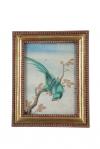  |
A COLLECTION OF FIVE EXPORT PAINTINGS.
Qing Dynasty.
Comprising a pair of paintings of birds, 37 x 30cm, two pith paintings of narrative scenes, 32 x 45cm, and a fan painting, 27cm H. (5)
£200-300
|
|
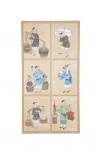 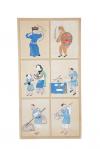 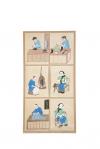 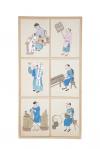 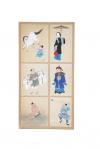 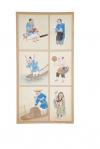 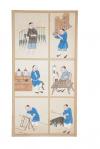 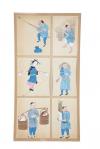 |
A SET OF FORTY-EIGHT EXPORT PAINTINGS OF TRADESMEN AND WOMEN.
Late Qing Dynasty.
Each painting 24 x 28cm, but mounted in sets of eight.
£400-600
|
|
    |
A SET OF FOUR PAINTINGS OF A MARRIAGE PROCESSION.
Late 19th / early 20th Century.
22 x 66cm. (4)
£200-300
| The following fourteen lots (290-303) are from the Collection of Mr (1926 -) and Mrs Chen (1930 -). | The Chens arrived in London in the late 1960s to set up as successful restaurateurs and were passionate collectors of Chinese art, mainly acquiring pieces within London since that date. They moved in circles of artists and connoisseurs and counted among their close friends the artists Fei Chengwu (1911-2000) and Zhang Qianying (1909-2003), lot 303 represents works directly gifted to them by the artists.
|

|
A GILT BRONZE JARDINIÈRE.
Qing Dynasty.
Raised on five feet, the compressed globular body with pierced scroll decoration interspersed with scrolling foliage, two stylised phoenix handles, key scroll decorated rim inlaid with circular amethyst stones, liner to the interior, 15cm H, 25cm diameter.
Provenance: Collection of Mr (1926 -) and Mrs Chen (1930 -).
£400-600
|
|

|
A PAIR OF GILT BRONZE CHAMPLEVÉ ENAMEL JARDINIÈRES.
Qing Dynasty, Qianlong period.
With four bracketed lobes, terminating in an everted flanged rim, decorated in the champlevé technique with lapis blue and turquoise enamels with leafy lotus blossom, the edge of the rim chased with key fret, four foot stands, ring handles suspended from leafy flower twin handles, original liners, 11cm H. (2)
Provenance: Collection of Mr (1926 -) and Mrs Chen (1930 -).
£800-1,200
|
|
  |
A COLLECTION OF SEVEN CHINESE BRONZE CENSERS.
Ming-Qing Dynasty.
9.5-17cm H. (7)
Provenance: Collection of Mr (1926 -) and Mrs Chen (1930 -).
£2,000-3,000
|
|
  |
A BRONZE CENSER.
Ming Dynasty.
Of bombé form with a tall neck, twin handles to the body, Da Ming Xuande nianzhi mark to base, carved and pierced wooden cover, 9cm H, 12cm diameter.
Provenance: Collection of Mr (1926 -) and Mrs Chen (1930 -).
£400-600
|
|

|
TWO SANCAI-GLAZED CENSERS.
Ming Dynasty.
One of rectangular form with flaring handles, fitted wooden stand and cover, 30cm H, together with a tripod censer with flaring handles, circular wood cover, 17.5cm H, 10cm diameter. (2)
Provenance: Collection of Mr (1926 -) and Mrs Chen (1930 -).
£400-600
|
|

|
A JADEITE CENSER AND COVER.
Second half of 20th Century.
The globular body supported by three lion foot legs emerging from lion-head masks, with twin openwork dragon head mask handles suspending freely moving rings, the domed cover surmounted by a carved and pierced dragon above four further handles suspending freely moving rings, wood stand, 15cm H.
Provenance: Collection of Mr (1926 -) and Mrs Chen (1930 -).
£200-300
|
|

|
A SET OF EIGHT HARDSTONE MINIATURE HORSE CARVINGS.
20th Century.
Carved from tiger-eye, rose quartz, agate and jade, wood stands, boxed, each horse 3.5cm H.
Provenance: Collection of Mr (1926 -) and Mrs Chen (1930 -).
£300-500
|
|

|
A COLLECTION OF GOLD AND JADEITE JEWELLERY.
Comprising necklaces, brooches, earrings and cufflinks. (Qty)
Provenance: Collection of Mr (1926 -) and Mrs Chen (1930 -).
£400-600
|
|
  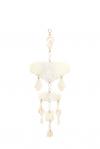 |
A COLLECTION OF JADE PENDANTS AND CARVINGS.
Qing Dynasty.
Comprising a jade bell, with carved wood stand and gong, a hanging jade ornament, a vase and cover with wooden stand, a pair of Buddhist lion dogs and an oval pendant with incised elephant mounted as a gilt metal box. (6)
Provenance: Collection of Mr (1926 -) and Mrs Chen (1930 -).
£800-1,200
|
|

